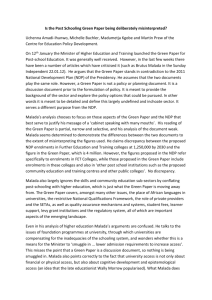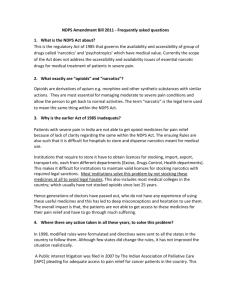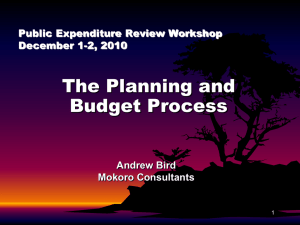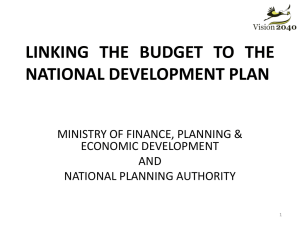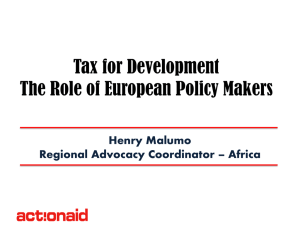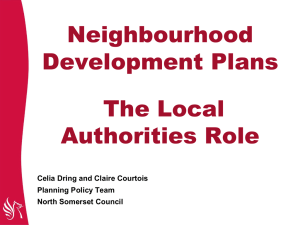NDP in Zambia, 2013-2016
advertisement
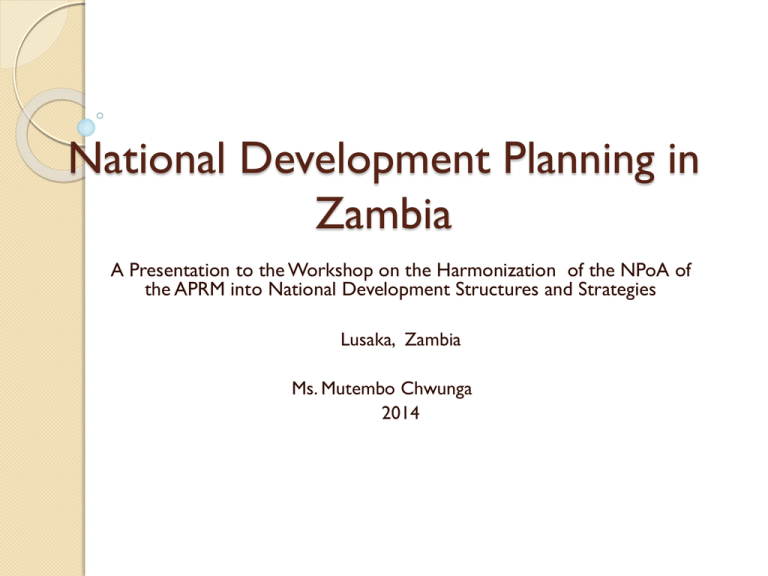
National Development Planning in Zambia A Presentation to the Workshop on the Harmonization of the NPoA of the APRM into National Development Structures and Strategies Lusaka, Zambia Ms. Mutembo Chwunga 2014 INTRODUCTION The 1990s observed an uncoordinated, haphazard and incoherent sector approaches to planning in Zambia ◦ Policy framework papers at institutional level guided development, ◦ Formed the basis for prioritisation and resource allocations ◦ Absence of inter-sectoral synergies This necessitated the re-emergency of long and medium-term national planning in 2002. INTRODUCTION CONT’D Significant strides made towards coordinated development planning processes since 2002 ◦ Poverty Reduction Strategy Paper (PRSP) 2002 – 2004 ◦ Transitional National Development Plan (TNDP) 2002 -2005 ◦ National Vision 2030 ◦ Fifth National Development Plan (FNDP) 2006 2010 ◦ Sixth National Development Plan (SNDP) 2011 – 2015 ◦ Revised National Development Plan (R-SNDP) 2013 -2016 NATIONAL DEVELOPMENT PLANNING PROCESS What does it take to develop a National Development Plan in Zambia? APPROACH Two approaches are used side by side ◦ Top Down ◦ Bottom Up And both are enshrined in the sectoral and regional focus of development. Thus, development programmes in the NDP should spring from either of these areas The interface with other sectors, provinces and districts is part of the chapter development process TOP DOWN Top Down ◦ Defining of Macroeconomic framework and setting of objectives and strategic focus ◦ Fiscal framework ◦ General guidelines in terms of ToRs given to SAGs, PDCCs and DDCCs TOP DOWN The ToRs highlight key issues of reference in drafting chapters for inclusion in the National Development Plan and among other things include:- ◦ Proposed programmes/policies should be aimed at achieving Vision 2030 ◦ Revision of sector past performance and its recommendations ◦ Reviewing of local and international agreements, resolutions and treaties such as SDGs, NEPAD, COMESA etc. to ensure are incorporated in the NDP ◦ Outline the roles that should be assigned to all identifiable stakeholders ◦ Cross cutting issues such as gender, environment etc are to be enshrined in programme design BOTTOM UP Bottom UP ◦ Stakeholder participation is vital for the successful implementation of the development plan ◦ Communities through DDCCs are engaged in meetings/workshops on the development issues affecting them and asked to recommend how these could be addressed ◦ DDCCs hold meetings to discuss overall district development based on the issues from the communities These DDCC meetings are special meetings as they may include participants not normally called to attend such as Councillors ◦ District priorities are submitted to PDCC for consideration BOTTOM UP ◦ PDCCs compile DDCCs reports to formulate Provincial development priorities and this is submitted to Ministry of Finance for consideration and inclusion into the NDP TYPES OF PLANS Long term – National Vision which is 25years Medium Term – National Development Plans which are 5 year long and are currently aimed at achieving Vision 2030 Medium Term Expenditure Framework – 3 years Annual National Budgets, these operationalise the NDPs Sector Specific Development Plans ◦ ◦ ◦ ◦ ◦ ◦ Roads Energy Agriculture Tourism Education Health MTEF /Annual Budgets NDPs Sector Specific Plans These vary in periods from 10 to 20 years Vision 2030 FORMULATION PROCESS OF Process NDPs takes at Defining the macroeconomic framework and setting the objectives and strategic focus least 2 years Policy guidance from Cabinet Situation Analysis & Forecasting/formulation of development scenarios Drafting of Chapters by Sectors/PDCCs/DDCCs Various Stakeholder Consultations - in form of meetings/workshops/written submissions This allows for interface between and across sectors & regions Consolidation & Final Drafting Validation Workshop Awareness & Sensitisations takes Launch by the President of the Republic and Dissemination of the Plan place throughout the design period National Development Plan IMPLEMENTATION OF NDPS The financing frame of the NDP indicates resource requirements and sources The Annual Budgets are the main tool of implementation of NDPs Programmes and Projects in Sector and Regional chapters in the NDP are implemented by MPSAs The plan covers a five year period MONITORING AND EVALUATION Annual progress reports Mid term review Evaluation at the end of the Plan period CHALLENGES IN THE NATIONAL DEVELOPMENT PLANNING PROCESS The planning process until this year has been adhoc ◦ Without written down procedures, timelines and processes and manuals ◦ Absence of a comprehensive legal framework ◦ Weak linkages between NDPs and the MTEF ◦ Weak linkages with different tiers of government ◦ District, provincial, sector and national plans have limited synergies HOPE IS THERE The development of the National Planning and Budgeting Policy, 2014 gives hope to address most of the challenges highlighted The policy is the torch bearer for the enactment of the Planning and Budgeting legislation THANK YOU FOR YOUR ATTENTION
